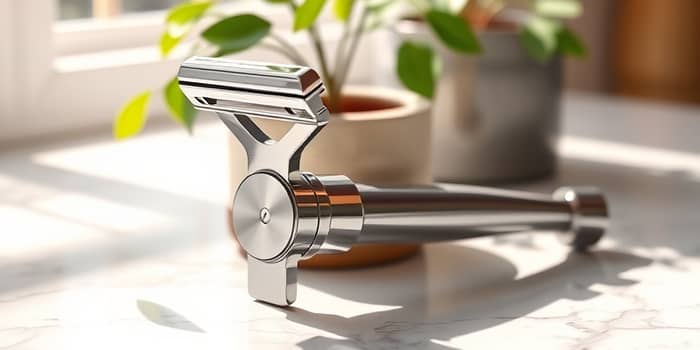In an age where convenience often comes at the expense of the planet, the humble safety razor is enjoying a remarkable renaissance. No longer seen as an antiquated tool, these reusable razors combine artisanal heritage with cutting-edge design, appealing to a new generation of eco-conscious consumers. From innovative materials to ergonomic shapes, they’re redefining what it means to shave—transforming a daily chore into a ritual of self-care and style.
Market landscape of reusable safety razors
The global safety razor market, valued between $3.5 and $5.7 billion in 2024, is poised to reach $4.8 to $7.76 billion by 2033 at a CAGR of 3.5% to 4%. Growth is fueled by the shift away from disposable plastic razors toward more sustainable grooming solutions. Brands are responding with stainless steel, carbon steel, and adjustable-blade models that cater to both performance and aesthetics.
Online sales channels have expanded access, allowing consumers to explore a wide range of options. From minimalist travel razors to limited-edition collaborations, the market is both fragmented and vibrant, with legacy companies and artisanal newcomers vying for attention.
- North America and Europe lead demand, driven by environmental awareness and higher disposable incomes.
- Asia-Pacific is emerging rapidly, balancing cost-consciousness with a growing appreciation for premium grooming rituals.
- Local and boutique brands carve out niches through bespoke designs and storytelling.
Environmental and cost advantages
Disposable razors generate massive plastic waste, much of which ends up in landfills. By contrast, safety razors provide minimal plastic waste and carbon footprint. High-quality metal construction ensures these razors can last a lifetime with proper care, reducing shaving-related waste by up to 70%.
Although the double-edge blade market faces a slight contraction, a loyal base of aficionados values the blades’ recyclability and precision. Over time, the initial investment pays off: a durable razor handle paired with blades costing mere cents each delivers substantial savings.
Innovation in design and inclusivity
Manufacturers are redefining what a safety razor can look like. Sleek, weighted handles crafted from stainless steel or brass merge with ergonomic contours for maximum shaving comfort. Customizable blade angles and twist-to-open mechanisms simplify blade swaps and fine-tune the shave.
Beyond function, brands embrace gender inclusivity, offering curated colorways and handle designs that cater equally to men and women. Limited-edition runs and design collaborations with artists elevate razors into collectible objects that double as style statements.
- Premium materials resist corrosion and develop a distinctive patina over time.
- Modular systems allow users to mix and match handles, bases, and blades.
- Compact travel models ensure a luxe shave on the go.
Evolution of consumer preferences
Today’s consumers prioritize products that align with their ethics and lifestyle. The traditional wet shaving ritual appeals for its meditative pace and skincare benefits, including reduced irritation and closer results. Those seeking an elevated daily routine are drawn to the premium shaving experience with customizable options and a tangible connection to classic craftsmanship.
Millennials and Gen Z, especially, respond to authentic brand narratives, social responsibility, and visually striking designs. They’re willing to invest more upfront when a product promises durability, performance, and aesthetic appeal.
- Shaving as self-care: turning a chore into a mindful practice.
- Heritage appeal: embracing time-tested techniques and materials.
- Community-driven endorsements: influencer and peer recommendations shape purchase decisions.
Hygiene and safety best practices
Proper cleaning and storage are key to ensuring both safety and razor longevity. After each shave, users should rinse the razor thoroughly, shake off excess water, and air-dry in a well-ventilated area. Monthly deep cleaning with alcohol or a mild disinfectant helps prevent bacterial buildup.
Professional shaving environments, such as barbershops, follow stringent protocols: razors are never shared, and tools are cleaned and sterilized between clients. Adhering to these guidelines guarantees a hygienic shave and aligns with industry standards.
Strategies of leading brands
Global players like Gillette and BIC face competition from artisanal labels such as Thiers-Issard and Hart Steel. Winning strategies include:
- Highlighting environmental impact metrics, such as waste reduction percentages and recycled packaging.
- Partnering with influencers and designers to position razors as lifestyle accessories.
- Offering subscription models for blade delivery, ensuring convenience and sustained customer engagement.
Limited-edition releases and co-branded products create urgency and exclusivity, transforming utilitarian items into coveted collectibles.
The future of shaving
The trajectory of the safety razor market is clear: consumers increasingly seek products that marry efficacy with ethics. As materials and manufacturing techniques advance, we’ll see even lighter, more durable designs that resonate with individual style preferences. Community-driven innovation—powered by feedback loops on social platforms—will shape the next generation of razor features.
By adopting a reusable razor, each of us contributes to a meaningful reduction in plastic waste, enjoys significant cost savings, and rediscovers the art of shaving. In this paradigm, grooming becomes more than a routine—it becomes an act of environmental stewardship and personal expression. The question is not if you’ll make the switch, but when.
References
- https://www.globalgrowthinsights.com/market-reports/safety-razor-market-103384
- https://www.businessresearchinsights.com/market-reports/safety-razor-market-110372
- https://www.datainsightsmarket.com/reports/safety-razor-1323954
- https://www.news.market.us/shaving-statistics/
- https://www.verifiedmarketreports.com/product/safety-razor-market/
- https://www.datainsightsmarket.com/reports/double-edge-safety-razor-blades-1880407
- https://www.revisor.mn.gov/rules/2105/full










